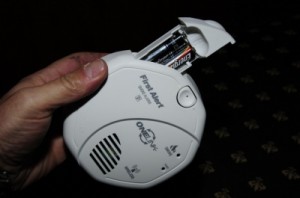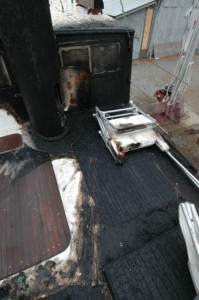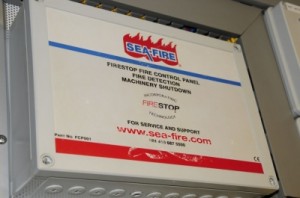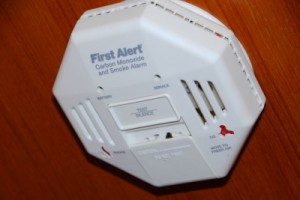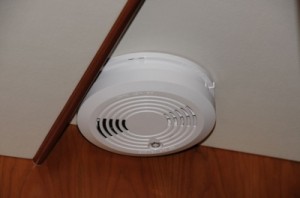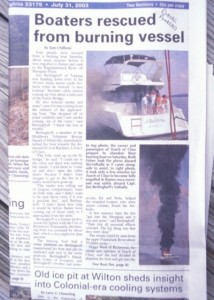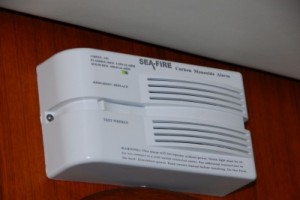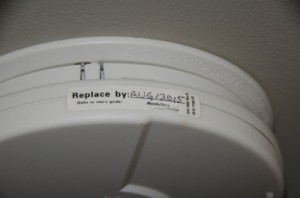Special Edition: Smoke Detectors
Special Report:
Smoke Detectors
How to Protect Yourself and Your Vessel
By Steve D’Antonio
All photos copyright Steve D’Antonio
Note: This is a special edition of my usual monthly blog. Part II of the Vessel Preparation blog will be released on time, at the end of January.
Thanks to ample sources of fuel and often a breeze, the rapidity with which marine fires spread can be breathtaking, and in many cases, fires that start aboard one vessel quickly move on to others. This vessel was severely damaged in a covered marina fire not far from my home. It was one of the lucky ones as it was later repaired.
Smoke Detectors
Why are smoke detectors so rarely found aboard cruising vessels? Reliable smoke detector technology has been around for decades. Much like their subsequently released carbon monoxide detector brethren, early smoke detectors went through a growing pain phase where false alarms were so frequent users tended to disable or remove them. This is another local case, a tragic one to be sure, and one I think about often. Ultimately, this fire claimed the life of the young girl and her father. The suspected cause, an electric space heater and faulty wiring. Could it have been prevented by a smoke detector? I believe the answer is, “yes.” Central station smoke and heat alarms (this one also shuts down engines, generators and ventilation systems in the event the engine room fixed fire extinguisher is discharged) are valuable indeed, and ideally suited to new builds. Selection As previously mentioned, an investment in smoke detectors for your vessel is very likely to be a small one. Fixed, hard wired, central-station type smoke, flame and heat detector systems for cruising vessels are of course more costly. They do, however, afford greater protection, notification and versatility. Several domestic units have highly desirable features that simply cry out for use aboard a cruising vessel. Combination internal battery-powered smoke and carbon monoxide alarms are inexpensive and readily available at home improvement stores and on line. There are a few caveats for their use aboard, however. Two such units, offered by Kidde http://www.kiddewireless.com/Kidde%20Safety%20-%20Wireless%20Smoke%20Alarm.htm http://www.firstalert.com/detectors/battery/onelink-battery/sa511cn2-3st A closed door can negate the effectiveness of a smoke alarm. Thus, for the cost, smoke alarms should be placed throughout your vessel, including on both sides of every door. Whichever units you choose, be sure to install one on both sides of every door in all berthing areas. That is, in the passageway outside a cabin door as well as inside the cabin. With this approach it becomes unlikely that a closed door could prevent an alarm from sensing smoke and sounding the alarm. Recommended locations for wireless interlinked smoke alarms: Folks who experience onboard fires nearly always make the same comment, “It spread so quickly.” Time is the key factor in fire prevention and detection; catching a potential confligration in the ‘smoldering phase’ is the goal. Sidebar: Detection Types Smoke detector technology, ionization or photoelectric, how does it work and which is best? Smoke detector technology falls into two possible categories, ionization and photoelectric. Most early smoke detectors were of the ionization variety, their detection ability relies on a small amount of radioactive material located between two electrically charged plates, which ionizes the air, which in turn causes current to flow. When smoke enters the chamber, the flow of ions is interrupted, which reduces current flow, triggering the alarm. Ionization detection is most sensitive for fast growing, flaming and less smoky fires. This technology has received a lot of bad press of late, much of it well deserved, many experts believe it to be inferior to photoelectric sensors. A client, and the owner of a smoke alarm service company that maintains thousands upon thousands of smoke alarms, has strong feelings regarding ionization smoke detector technology, saying, “…quite simply, ionization smoke alarms are potential killers, in that they do not respond in most real house [and boat – SDA] fire situations. I couldn’t tell you how many houses we have been to where there has been a smoldering fire, house full of smoke and not one alarm has actually gone off. In every case, the alarms have been ionization.” Photoelectric detection works very differently, however, it’s also very simple, a light source within the detector is aimed away from a light sensor. When smoke enters the chamber it reflects the light onto the sensor, which triggers the alarm. Photoelectric smoke detection is more sensitive to smoky, smoldering fires. The US testing firm and publication “Consumer Reports” recommends that both technologies be used in the ideal, single detector. That may be a tall order to get that and all the features you want. If you must choose one, therefore, photoelectric is preferred as it’s more sensitive to the more common type of fire, especially aboard a boat. The chosen detector should also carry a UL217 approval. The Coast Guard requires that smoke detectors/alarms be installed in the sleeping compartments of inspected vessels (those carrying paying passengers). Under CG guidelines, the smoke detector should meet Underwriters Laboratories standard 217. The National Fire Protection Association also calls for adherence to UL 217 in vessels over 26’ (10.7m). Carbon Monoxide Detectors Stand-alone carbon monoxide detectors that are powered from the vessel’s own DC system, like the one shown here, are equally as important and necessary as smoke detectors. Internal battery-powered units are just as effective, however, users must remember to replace batteries religiously. Unfortunately, other than in the aforementioned central station or in 120-volt AC versions, hard-wired smoke alarms in the CO alarm style described above and designed for marine or RV applications are not readily available. (120-VAC hard wired/9-volt internal battery/RF versions such as the model shown herehttp://www.firstalertstore.com/store/catalog.asp?item=1235 This smoke alarm is capable of communicating with, and setting off other units like it throughout the vessel. The value of this type of alarm cannot be over-estimated. For the cost, it’s very likely the cheapest insurance you will ever buy. Replace Batteries Regularly The lifespan of a smoke detector itself is finite. Most manufacturers specify replacement every ten years and some even sound an ‘end of life signal’. For marine use, a conservative replacement schedule is every five years. For more information on the services provided by Steve D’Antonio Marine Consulting, Inc. please e mail Steve at info@stevedmarineconsulting.com or call 804-776-0981
